Labour Force
- Home
- Statistics
- Labour Market
- Labour Market Information
- Labour Force
Key Statistics of Labour Force in Malaysia, May 2022
Key Statistics of Labour Force in Malaysia, April 2022 10 May 2022
Key Statistics of Labour Force in Malaysia, March 2022 10 May 2022
Principal Statistics of Labour Force, Malaysia, First Quarter (Q1) 2022 27 April 2022
Labour Force Survey Report, Malaysia, 2021 8 April 2022
Key Statistics of Labour Force in Malaysia, February 2022 9 March 2022
Key Statistics of Labour Force in Malaysia, January 2022 Show all release archives
Overview
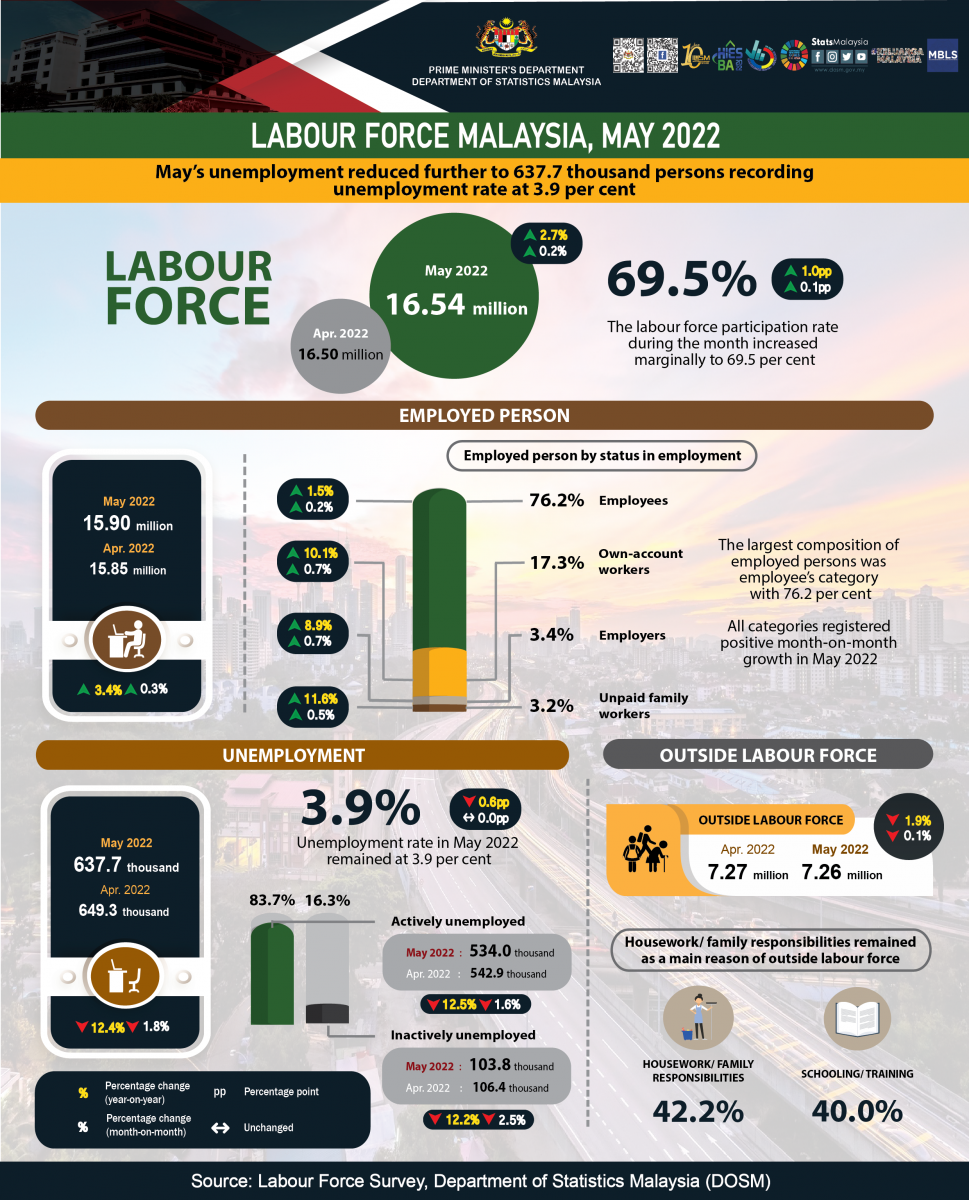
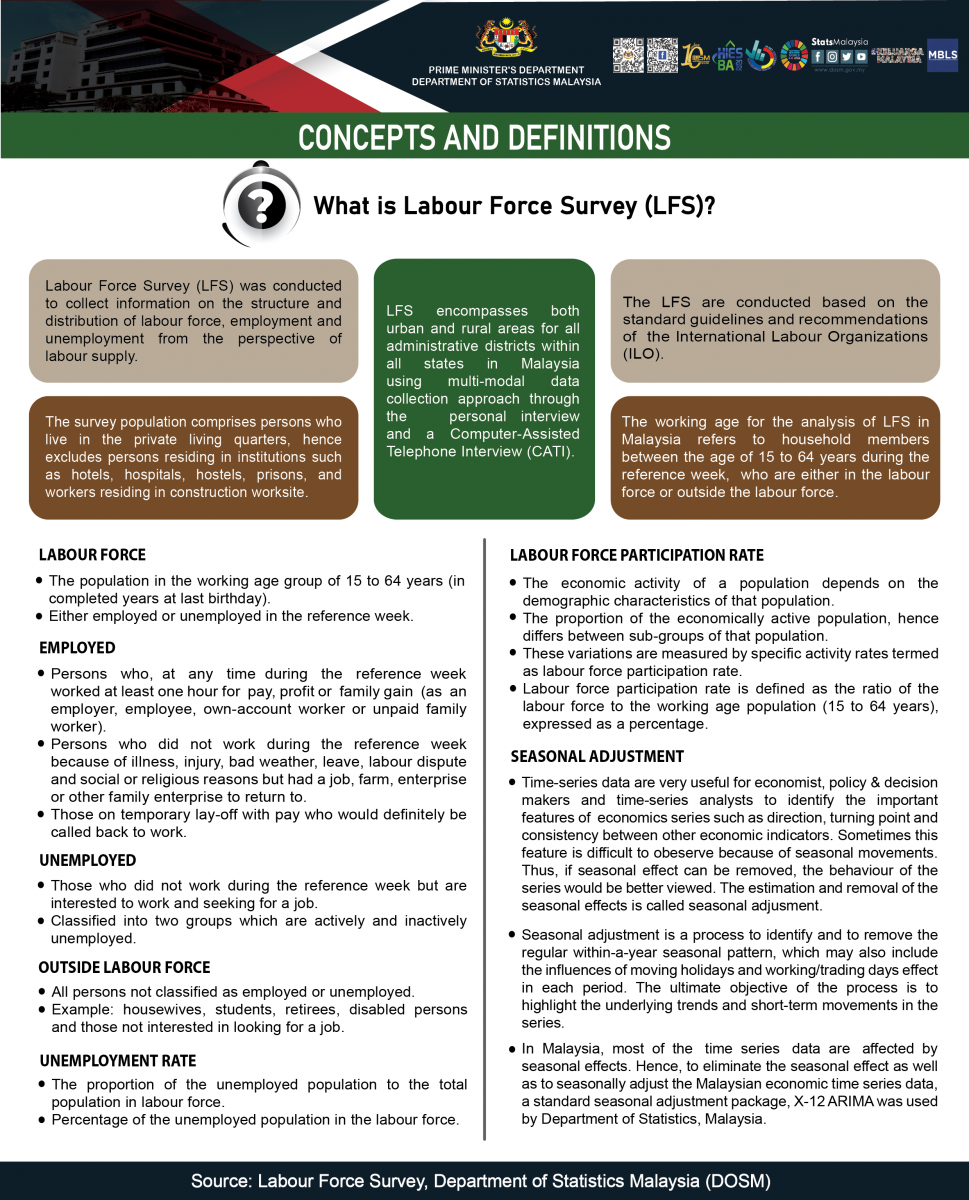
KEY REVIEWS
- In May 2022, the number of employed persons ascended further by 46.5 thousand persons (+0.3%) to record 15.90 million persons (April 2022: 15.85 million persons). In terms of seasonally adjusted, the number of employed persons increased by 0.3 per cent. During the month, the employment-to-population ratio which indicates the ability of an economy to create employment rose by 0.1 percentage points to 66.8 per cent as compared to the previous month (April 2022: 66.7%).
- Looking at the employed persons by economic sector, Services sector continued to record a positive growth in employment largely in Wholesales & retail trade; Information & communication and Food & beverage services activities. Similarly, Agriculture, Manufacturing and Construction sectors also remained its positive trend in the number of employed persons except for Mining & quarrying sector which was still on a declining trend.
- The largest composition of employed persons was employee’s category with 76.2 per cent. This category posted a rise of 0.2 per cent (+20.1 thousand persons) to record 12.11 million persons as compared to the previous month (April 2022: 12.09 million persons). Meanwhile the own-account workers which consist of mostly of daily income earners working as small business such as small retailers; hawkers; sellers in market and stalls; as well as smallholders, also improved with an addition of 20.4 thousand persons (0.7%) to 2.74 million persons (April 2022: 2.72 million persons).
- The number of unemployed persons in May 2022 continued to decline with a reduction of 1.8 per cent (-11.6 thousand persons) to record 637.7 thousand unemployed persons (April 2022: 649.3 thousand persons). In the meantime, on seasonally adjusted terms, the number of unemployed persons descended by 1.4 per cent. Therefore, the unemployment rate during the month remained at 3.9 per cent, while seasonally adjusted estimates for May’s unemployment rate decreased marginally by 0.1 percentage points to 3.8 per cent.
- The number of labour force recorded a month-on-month increase of 0.2 per cent (+35.0 thousand persons) to register 16.54 million persons in May 2022 (April 2022: 16.50 million persons). Consequently, the labour force participation rate (LFPR) during the month increased marginally to 69.5 per cent (April 2022: 69.4%). In terms of seasonally adjusted estimates, the number of labour force decreased by 0.3 per cent while LFPR rose by 0.1 percentage points.
- In May 2022, the number of persons outside labour force remained on a declining trend for ten consecutive months with a reduction of 10.1 thousand persons (-0.1%) to register 7.26 million persons (April 2022: 7.27 million persons). Housework/ family responsibilities remained as a main reason of outside labour force with a contribution share of 42.2 per cent and this was followed by schooling/ training category with 40.0 per cent.
-
The crisis of rising prices of commodity prevailing in the market, had indirectly impacted the Malaysia's economic development. The increase in the price of goods will result in inflation that will affect the country's economic recovery. In addition, Zero-COVID Policy implemented by China has caused to the shortcomings and delays in the supply of materials, thus affecting the global market, especially in the manufacturing sector. However, the operation of all economic sector and social activities is observed as a contributing factor to the increase in demand for labour. In addition, the entry of foreign labour into the country to cope with labour shortages in certain industries is also foreseen as a positive element in ensuring that the labour market remains stable even though it will lead to higher competition and a tight labour market. Thus, the labour market is anticipated to be in a positive recovery momentum in the upcoming months, but does not considering the impending effects of the inflationary pressure globally.
MAY’S LABOUR FORCE SITUATION REMAINS RESILIENT WITH STEADY EMPLOYMENT GROWTH WHILE UNEMPLOYMENT REDUCED FURTHER
Economic situation in Malaysia is getting brisk in line with the transition phase to endemic whereby all economic activity continued to operate including the activities which was prohibited from operating in the negative list of Majlis Keselamatan Negara (MKN) prior to this month. Even though the number of daily cases and hospitalisation rise after Hari Raya Aidilfitri, the situation remained under control, with no significant increases in daily new cases and low death rate due to COVID-19. According to the Chairman of Bursa Malaysia Berhad, Tan Sri Abdul Wahid Omar, the country’s growth outlook is seen to be as one of the factors to be optimistic as the country was in the transition phase to endemic with the easing of pandemic control restriction and the reopening of international borders. Furthermore, this situation is anticipated to contribute to the revitalisation of Malaysia's tourism sector which supports 3.5 million jobs.
Therefore, the recovery of the labour market in May 2022 continued to be stable aligned with full operation of all economic activities. This encouraging economic activities during the month stimulated more demand for goods and services thus providing more opportunities for businesses to revive their revenues. The labour market is also seen to expand as more demand and supply of labour prevails in the market to accommodate the needs of the growing economic activities. Thus, the labour force situation during the month remained resilient with steady employment growth while unemployment reduced further.
On the other hand, the Leading Index (LI) in April 2022 registered a better negative growth to negative 0.5 per cent from negative 1.4 per cent in March 2022, signifying better economic recovery ahead. In the meantime, the monthly external trade indicators for export registered a decreased of 5.6 per cent (April 2022: -3.0%) while import posted a positive growth of 3.6 per cent (April 2022: -0.8%).
Number of employed persons ascended further in May 2022
In May 2022, the number of employed persons ascended further by 46.5 thousand persons (+0.3%) to record 15.90 million persons (April 2022: 15.85 million persons). In terms of seasonally adjusted, the number of employed persons increased by 0.3 per cent. As for the year-on-year basis, the number of employed persons remained in an upward trend with an increase of 3.4 per cent (+529.2 thousand persons) as compared to 15.37 million persons in May 2021.
Looking at the employed persons by economic sector, Services sector continued to record the positive growth in employment largely in Wholesales & retail trade; Information & communication and Food & beverage services activities. Similarly, Agriculture, Manufacturing and Construction sectors also remained its positive trend in the number of employed persons except for the Mining & quarrying sector which was still on a declining trend.
During the month, the employment-to-population ratio which indicates the ability of an economy to create employment rose by 0.1 percentage points to 66.8 per cent as compared to the previous month (April 2022: 66.7%). Similarly, the ratio rose by 1.4 percentage points as against the same month of the preceding year (May 2021: 65.4%). [Chart 1]
Chart 1: Employed persons and employment-to-population ratio, January 2018 - May 2022
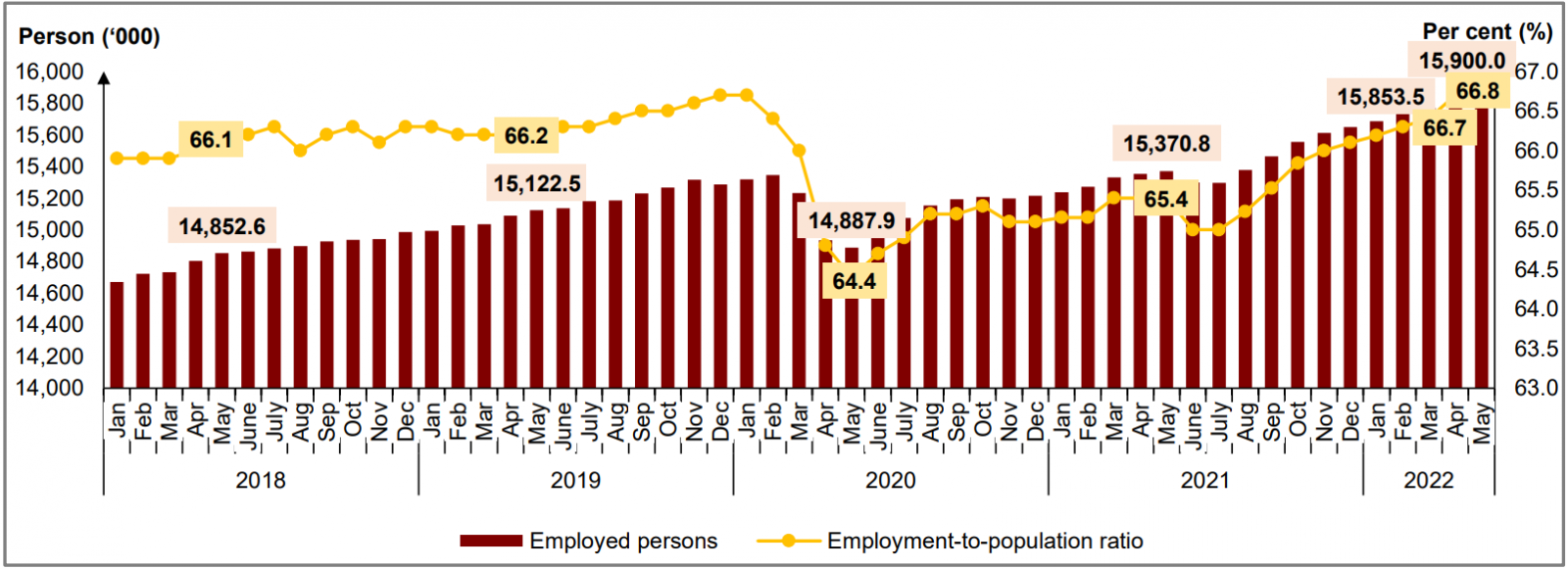
The largest composition of employed persons was employee’s category with 76.2 per cent. This category posted a rise of 0.2 per cent (+20.1 thousand persons) to record 12.11 million persons as compared to the previous month (April 2022: 12.09 million persons). Meanwhile, the own-account workers which consist of mostly of daily income earners working as small business such as small retailers; hawkers; sellers in market and stalls; as well as smallholders, also improved with an addition of 20.4 thousand persons (0.7%) to 2.74 million persons (April 2022: 2.72 million persons). [Chart 2]
Chart 2: Employed person by status in employment, April and May 2022
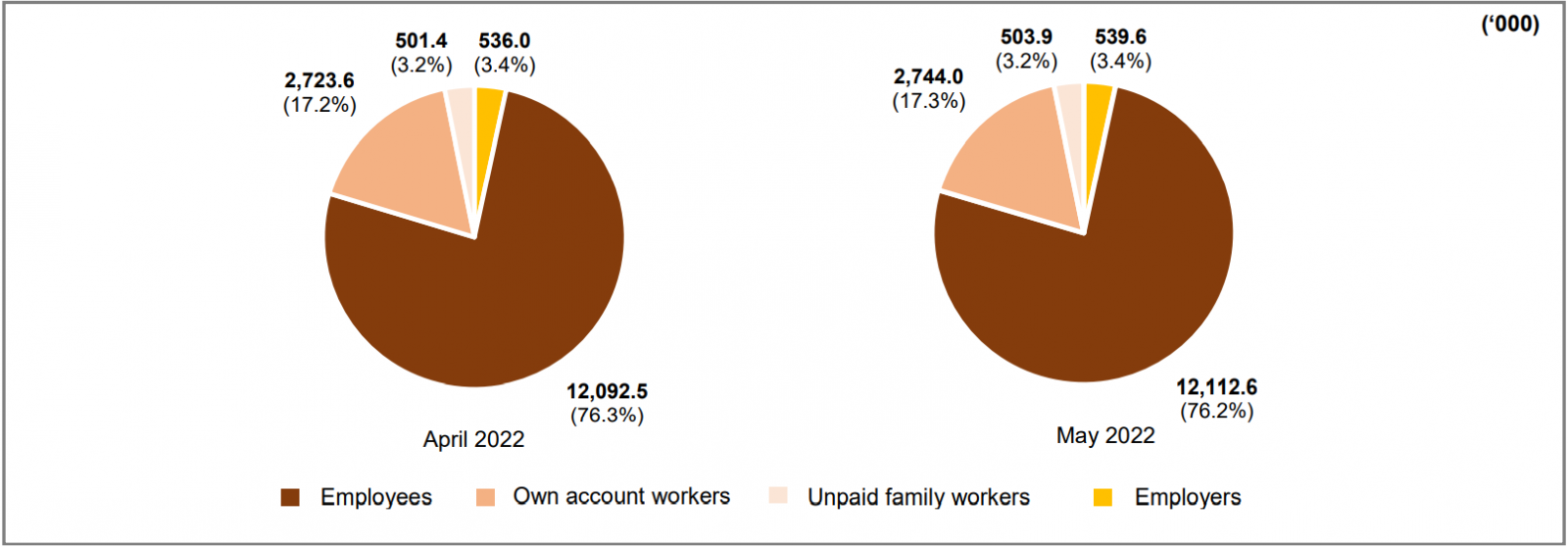
In May 2022, the number of employed persons who were temporarily not working rose by 6.5 per cent or equivalent to 5.8 thousand persons to register 94.1 thousand persons as compared to 88.3 thousand persons in April 2022. The increase was partly due to the festive season during the month. Year-on-year comparison, this category reduced by 45.6 thousand persons or 32.7 per cent (May 2021: 139.6 thousand persons). This group of persons, who were most likely not able to work were not categorised as unemployed as they had work to return to.
Unemployment rate in May 2022 remained at 3.9 per cent
The number of unemployed persons in May 2022 continued to decline with a reduction of 1.8 per cent (-11.6 thousand persons) to record 637.7 thousand unemployed persons (April 2022: 649.3 thousand persons). In the meantime, on seasonally adjusted terms, the number of unemployed persons descended by 1.4 per cent. Therefore, the unemployment rate during the month remained at 3.9 per cent, while seasonally adjusted estimates for May’s unemployment rate decreased marginally by 0.1 percentage points to 3.8 per cent.
As compared to May 2021, the number of unemployed persons were also on a declining trend for fourteen conservative months with a decline of 12.4 per cent or equivalent to 90.4 thousand persons (May 2021: 728.1 thousand persons). Accordingly, the unemployment rate decreased by 0.6 percentage points as compared to 4.5 per cent in the same month of the previous year. [Chart 3]
Chart 3: Unemployed persons and unemployment rate, 1982 - 2021 and January 2020 - May 2022

In terms of unemployment category, 83.7 per cent of the total unemployed persons were those who were available for work and were actively seeking jobs or the actively unemployed. This category fell by 1.6 per cent (-8.9 thousand persons) to register 534.0 thousand persons (April 2022: 542.9 thousand persons). By duration of the unemployment for the actively unemployed, 58.6 per cent were those who were unemployed for less than three months, while 6.9 per cent were those who were in the long-term unemployment of more than a year. In the meantime, the inactively unemployed or those who believed that there were no jobs available decreased continuously, with a decline of 2.5 per cent (-2.6 thousand persons) to 103.8 thousand persons (April 2022: 106.4 thousand persons). [Chart 4]
Chart 4: Unemployed category and duration of unemployment, April and May 2022

During the month, the youth unemployment rate for those aged 15 to 24 years continued to record a decrease, with a fall of 0.3 percentage points to 12.5 per cent. Meanwhile, the number of unemployed youths reduced by 15.8 thousand persons (-4.4%) to 341.4 thousand persons (April 2022: 357.2 thousand persons). Similarly, the unemployment rate for youth aged 15 to 30 years edged down by 0.3 percentage points to 7.4 per cent, recording lower number of unemployed youths at 475.7 thousand persons (April 2022: 7.7%; 501.2 thousand persons). [Chart 5]
Chart 5: Unemployment rate by selected age groups, 1982 - 2021 and January 2020 - May 2022
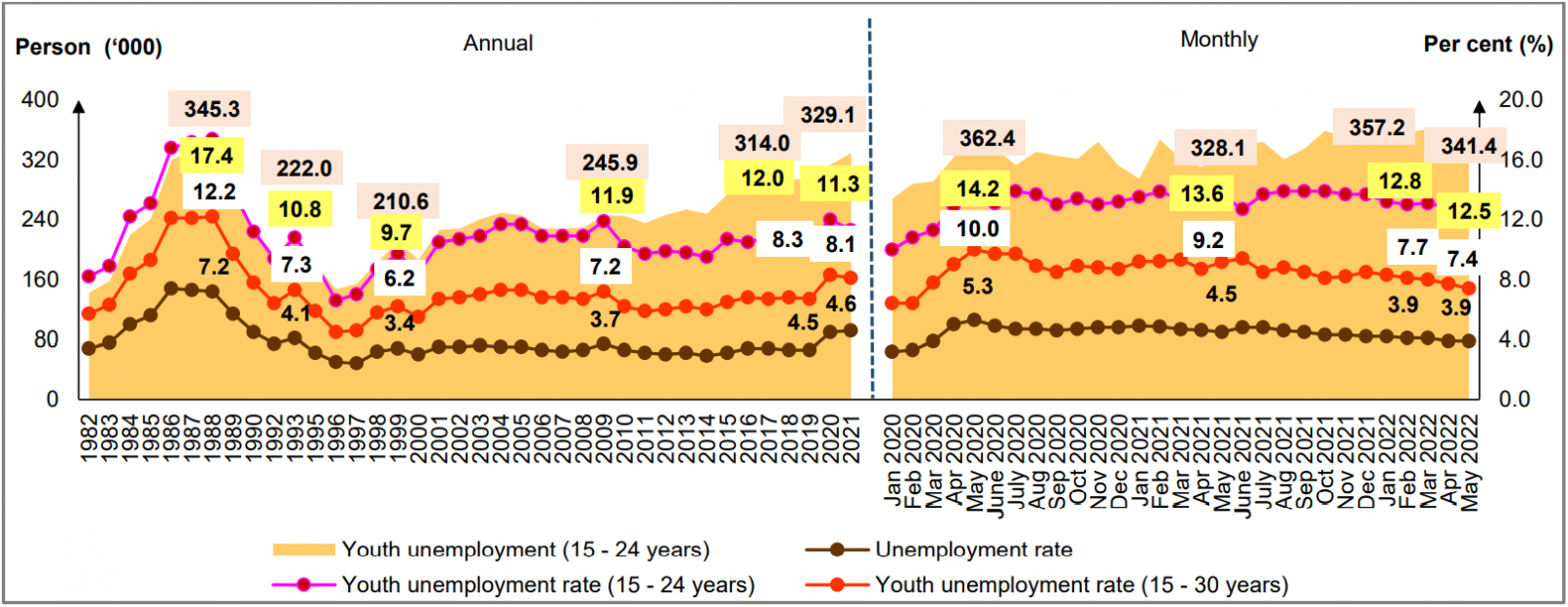
LFPR increased marginally to 69.5 per cent
The number of labour force recorded a month-on-month increase of 0.2 per cent (+35.0 thousand persons) to register 16.54 million persons in May 2022 (April 2022: 16.50 million persons). Consequently, the labour force participation rate (LFPR) during the month increased marginally to 69.5 per cent (April 2022: 69.4%). In terms of seasonally adjusted estimates, the number of labour force decreased by 0.3 per cent while LFPR rose by 0.1 percentage points.
Comparing with the same month of the previous year, the number of labour force improved by 2.7 per cent or equivalent to 438.9 thousand persons (May 2021: 16.10 million persons). Therefore, the LFPR heightened by 1.0 percentage points as compared to May 2021 (68.5%). [Chart 6]
Chart 6: Labour force and LFPR, 1982 - 2021 and January 2020 - May 2022

In terms of labour force by sex, male labour force continued to rise during the month to record 10.15 million persons (April 2022: 10.15 million persons) as well as female labour force also increased to 6.38 million persons (April 2022: 6.36 million persons). Therefore, both male and female LFPR climbed by 0.2 percentage points and 0.1 percentage points to register 82.5 per cent and 55.6 per cent respectively. Year-on year, male LFPR ascended by 1.4 percentage points (May 2021: 81.1 %), while female LFPR augmented by 0.4 percentage points (May 2021: 55.2%). [Chart 7]
Chart 7: Labour force and LFPR by sex, 1982 - 2021 and January 2020 - May 2022
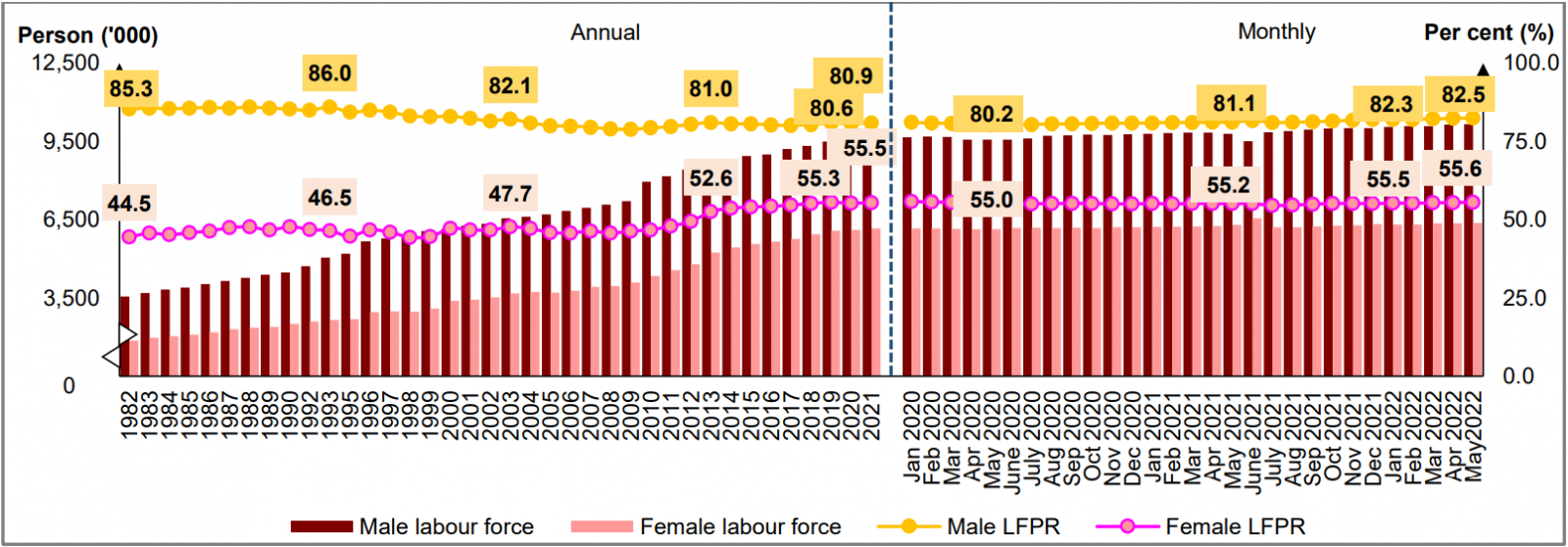
Housework/ family responsibilities remained as a main reason of outside labour force
In May 2022, the number of persons outside labour force remained on a declining trend for ten consecutive months with a reduction of 10.1 thousand persons (-0.1%) to register 7.26 million persons (April 2022: 7.27 million persons). Likewise, year-on-year, the number of this group posted a decline of 137.9 thousand persons or 1.9 per cent (May 2021: 7.40 million persons). Housework/ family responsibilities remained as a main reason of outside labour force with a contribution share of 42.2 per cent and this was followed by schooling/ training category with 40.0 per cent. [Chart 8]
Chart 8: Share of outside labour force by reasons for not seeking work, April and May 2022
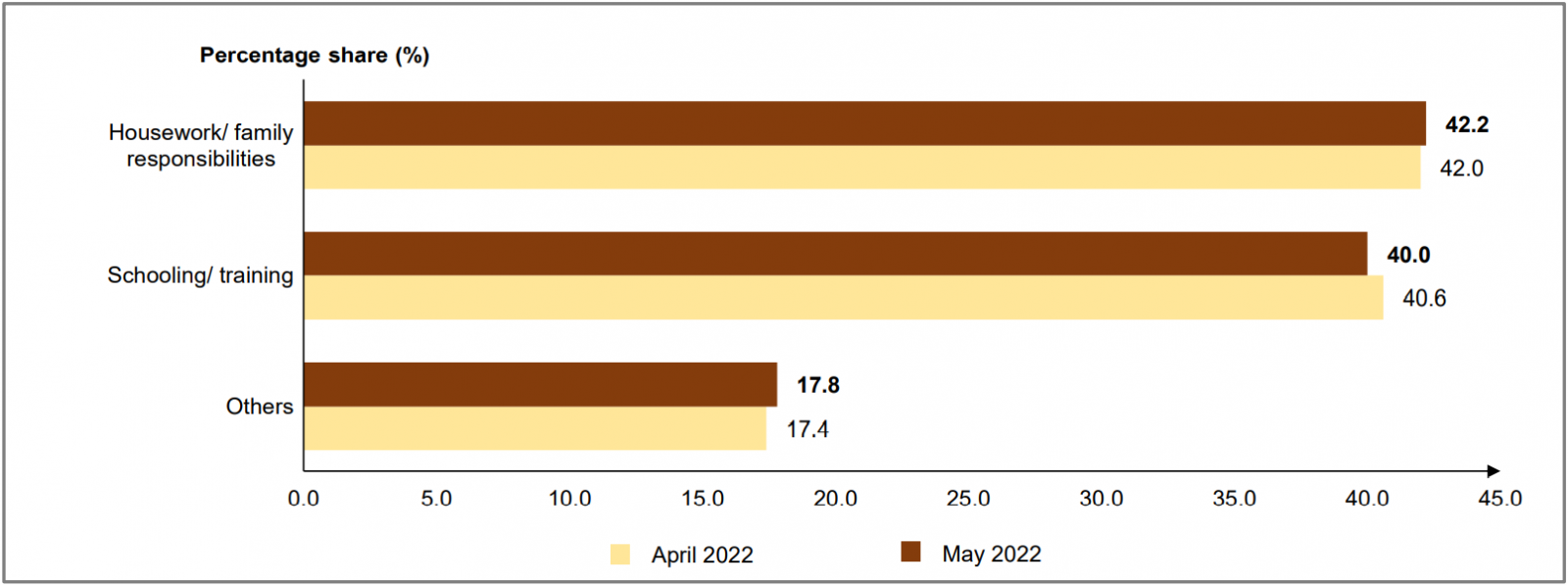
GOVERNMENT’S INITIATIVES
Under the PRIHATIN package, the Wage Subsidy Program (PSU) is a financial assistance paid to employers for each enterprise to support employers to continue their operations and retain employees. As of 10 June 2022, PSU 1.0 had benefited 322,177 employers and 2.64 million registered employees with a total approved value of RM12.96 billion. Moreover, through PSU 2.0 under the Kita PRIHATIN Package, a total of RM1.41 billion was channelled to 81,158 employers, enabling them to continue operating and retain 718,647 employees. Subsequently, under PSU 3.0, 162,305 employers have been assisted in retaining 1.53 million employees with a value of RM3.76 billion. Next, under PEMULIH packages, a total value of RM2.56 billion was channelled to 163,431 employers and 1.92 million employees through PSU 4.0. In addition, a total of RM183.12 million was channelled to 7,385 employers to retain 105,300 employees through PSU 5.0.
Furthermore, through the JaminKerja Recruitment Incentive Programme with a collaboration of SOCSO has successfully placed 75,932 employees as of 13 May 2022, and this effort will create 300,000 new job opportunities as well as to reduce unemployment among Malaysian citizens. Also, there were 3,625 youths have been successfully positioned through this incentive programme under National Apprenticeship Scheme (SPN) which was specifically designed for the apprentice group under the Ministry of Youth and Sports in collaboration with other ministries such as the Ministry of Works and Ministry of Human Resources and Federal Agencies under all three ministries as of 10 June 2022. Additionally, through the Ministry of Higher Education's Career Advancement Programme (KPT-CAP), a total of 3,618 graduates were successfully placed via this programme.
Through MyDigitalWorkforce Work in Tech (MYWiT), a total of 892 participants from 3,763 applicants were successfully placed in technology and digital services jobs as of 10 June 2022. In addition, through the Professional Training and Education for Growing Entrepreneurs (PROTEGE) initiative under the Ministry of Entrepreneur Development and Cooperatives (MEDAC), for the implementation of the employability improvement programmes and foster entrepreneurial skills among graduates, a total of 4,053 graduates were successfully placed as of 10 June 2022. Besides, the ATM Veterans Reskilling and Upskilling Programme (PRUV-ATM) which was implemented to improve the socio-economic status of veterans, whereby veterans will be trained to enhance their knowledge and skills for the employment and entrepreneurship sectors, a total of 8,736 veterans were assisted in this programme as of 10 June 2021.
For business empowerment, as of 31 May 2022, a total of RM3.46 million was approved to assist 395 new entrepreneurs under the Youth/ MARA Educational Institution Graduate Entrepreneur Programme (PUTRA), which was designed to provide financing facilities for micro businesses in all sectors, except agriculture and livestock farming, and to produce dynamic entrepreneurs among the younger generation who are eager to start a business. Next, through the Technical Entrepreneur Development Programme (PUTEK), which was a financial facility for the younger generation to start a business in a technical field based on the abilities obtained under MARA, a total of RM2.44 million was channelled to 31 MARA technical entrepreneurs. In addition, under Women Special Business Financing Scheme (DanaNITA), a total of RM10 million has been approved to assist 265 women entrepreneurs who were affected by COVID-19 and to increase their business capacity as of 20 May 2022. Furthermore, with an allocation of RM8.0 billion, the Targeted Relief and Residual Facility (TRRF) was issued as a lending facility to assist 24,962 Small and Medium Enterprises (SMEs) which was affected in the services sector from 35,431 applications involving a total value of RM5.86 billion as of 31 May 2022.
In addition, under the Agrofood Facilities (AF) provided by Bank Negara Malaysia (BNM), with the goal of driving the modernisation of the agricultural sector in order to improve food security and safety, generate higher income and attract more younger agropreneurs, a total of 2,997 applications were received with 2,253 approved applications totalling RM1.77 billion. Next, a total of RM3.1 million was approved for ten professionals to venture into entrepreneurship through the Professional Financing Scheme (ProSPEC) under MARA, which aims to provide business facilities and increase the participation of Bumiputera entrepreneurs in the field of professional entrepreneurship as of 31 May 2022. Moreover, a strategic programme under TEKUN meant to assist the Indian community in developing their economy through business and entrepreneurship under the Indian Community Entrepreneur Development Scheme (SPUMI), a total of RM21.72 million was channelled to support 902 Micro SMEs as of 20 May 2022.
Through the PENJANA Tourism Financing programme, which was specifically allocated for Bumiputera SMEs to support SMEs and micro-SMEs which were still affected by the COVID-19 pandemic, there were 407 applications out of 774 financing applications, involving a total fund allocation of RM83.68 million as of 3 June 2022. Next, to support and encourage SMEs and Technical and Digital Mid-tier Companies (MTCs) to digitalise their operations and trade channels, a total of RM92.9 million had been channelled to 13,893 businesses in the form of grants and loans for digitalisation services subscriptions. Moreover, to support the Arts, Culture, and Entertainment Sector, a total of RM7.24 million were allocated to 590 recipients, including artists and organisations who were actively involved in the Malaysian Arts and Culture industry under the CENDANA programme as of 27 May 2022.
LOOKING AHEAD
The crisis of rising prices of commodity prevailing in the market, had indirectly impacted the Malaysia's economic development. The increase in the price of goods will result in inflation that will affect the country's economic recovery. In addition, Zero-COVID Policy implemented by China has caused to the shortcomings and delays in the supply of materials, thus affecting the global market, especially in the manufacturing sector.
However, the operation of all economic sector and social activities is observed as a contributing factor to the increase in demand for labour. In addition, the entry of foreign labour into the country to cope with labour shortages in certain industries is also foreseen as a positive element in ensuring that the labour market remains stable even though it will lead to higher competition and a tight labour market. Thus, the labour market is anticipated to be in a positive recovery momentum in the upcoming months, but does not considering the impending effects of the inflationary pressure globally.
TECHNICAL NOTES
This information is derived from the Labour Force Survey (LFS) which was conducted to collect information on the structure and distribution of labour force, employment and unemployment.
The survey population cover persons who live in private living quarters and excludes persons residing in institutions such as hotels, hostels, hospitals, prisons, boarding houses and workers residing in construction work site.
The survey comprises of the economically active and inactive population. To measure the economically active population, the LFS uses the age limit of 15 to 64 years. The economically active population comprises of those employed and unemployed whereas those who are inactive is classified as outside the labour force.
LFS uses the actual status approach, where a person is classified on the basis of his labour force activity during the reference week.
- Labour force refers to those who, during the reference week are in the 15 to 64 years (in completed years at last birthday) and who are either employed or unemployed.
- Employed refers to all persons who, at any time during the reference week worked at least one hour for pay, profit or family gain (as an employer, employee, own-account worker or unpaid family worker). Also considered as employed are persons who did not work during the reference week because of illness, injury, bad weather, leave, labour dispute and social or religious reasons but had a job, farm, enterprise or other family enterprise to return to. Also included are those on temporary lay-off with pay who would definitely be called back to work.
- Unemployed
Unemployed refers to those who do not have a job but are interested to work. There are two groups of unemployed that is the actively unemployed and inactively unemployed.
- Outside Labour Force
All persons not classified as employed or unemployed as stated above are classified as outside labour force. Includes housewives, students (including those going for further studies), retired, disabled persons and those not interested in looking for a job.
- Labour Force Participation Rate
The economic activity of a population depends on the demographic characteristics of that population. The proportion of economically active population, therefore, differs between sub-groups of that population. These variations are measured by specific activity rates termed as labour force participation rate. Labour force participation rate is defined as the ratio of the labour force to the working age population (15 to 64 years), expressed as percentage.
- Unemployment rate is the proportion of unemployed population to the total population in labour force. This rate measures the percentage of unemployed population in the labour force.
Population by characteristics of age group, ethnicity and state were used as benchmarks to produce labour statistics.
Starting with the monthly release of the Principal Statistics of Labour Force, Malaysia, January 2016, the principal statistics of labour is estimated based on the current population estimates as compared to the previous series which used population projections based on the Population and Housing Census of Malaysia, 2010. This rebase is to obtain statistics that is more consistent with current population structure.
The full publication of the Labour Force Report, May 2022 can be downloaded through eStatistik Portal.
For more details, please refer to the Department’s portal: www.dosm.gov.my
Released by:
DEPARTMENT OF STATISTICS, MALAYSIA
07 JULY 2022
Contact person:
Mohd Yusrizal bin Ab. Razak
Public Relation Officer
Strategic Communication and International Division
Department of Statistics, Malaysia
Tel : +603-8885 7942
Fax : +603-8888 9248
Email : yusrizal.razak@dosm.gov.my
Subscribe
Newsletter
Subscribe to our newsletter and stay updated
For interviews, press statement and clarification to the media, contact:
Baharudin Mohamad
Public Relation Officer
Email: baharudin[at]dosm.gov.my
Phone: 03 8090 4681
Not found what you looking for? Request data from us, through
Go to eStatistik
Email: data[at]dosm.gov.my
Phone: 03 8885 7128 (data request)










